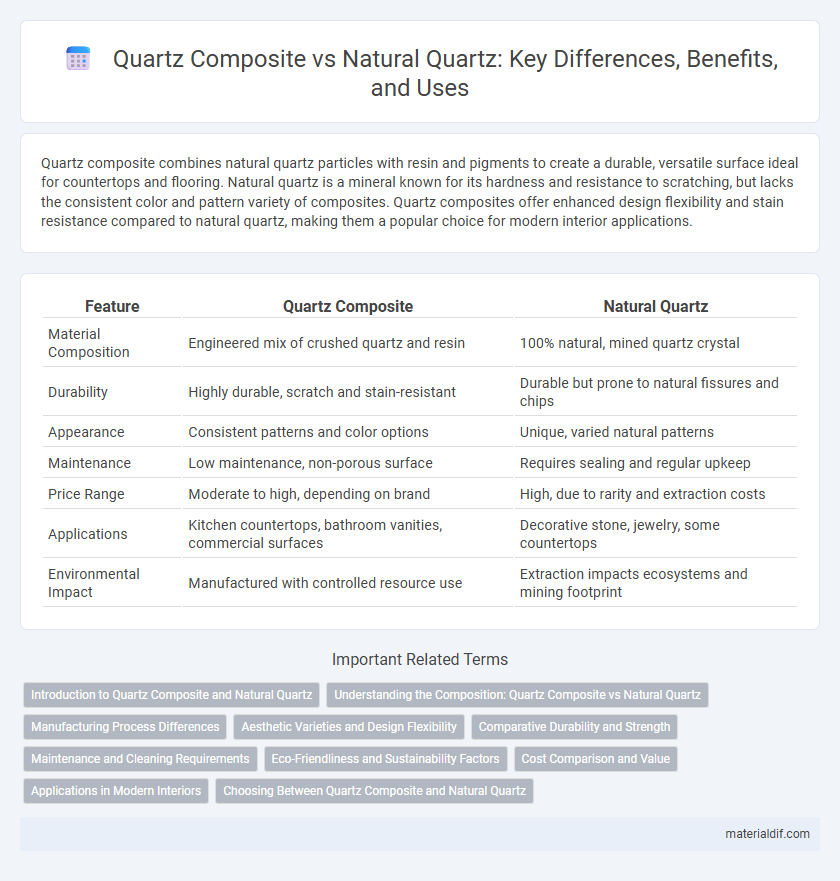Quartz composite combines natural quartz particles with resin and pigments to create a durable, versatile surface ideal for countertops and flooring. Natural quartz is a mineral known for its hardness and resistance to scratching, but lacks the consistent color and pattern variety of composites. Quartz composites offer enhanced design flexibility and stain resistance compared to natural quartz, making them a popular choice for modern interior applications.
Table of Comparison
| Feature | Quartz Composite | Natural Quartz |
|---|---|---|
| Material Composition | Engineered mix of crushed quartz and resin | 100% natural, mined quartz crystal |
| Durability | Highly durable, scratch and stain-resistant | Durable but prone to natural fissures and chips |
| Appearance | Consistent patterns and color options | Unique, varied natural patterns |
| Maintenance | Low maintenance, non-porous surface | Requires sealing and regular upkeep |
| Price Range | Moderate to high, depending on brand | High, due to rarity and extraction costs |
| Applications | Kitchen countertops, bathroom vanities, commercial surfaces | Decorative stone, jewelry, some countertops |
| Environmental Impact | Manufactured with controlled resource use | Extraction impacts ecosystems and mining footprint |
Introduction to Quartz Composite and Natural Quartz
Quartz composite is an engineered material made by combining natural quartz crystals with resin and pigments, resulting in a highly durable, non-porous surface ideal for countertops and flooring. Natural quartz is a crystalline mineral found in the earth, prized for its hardness and resistance to heat, but it often requires sealing to prevent staining. Quartz composite offers greater design flexibility and uniformity compared to natural quartz, making it a popular choice in modern interior design.
Understanding the Composition: Quartz Composite vs Natural Quartz
Quartz composite consists of approximately 90% ground natural quartz combined with resin and pigments, creating a durable, non-porous surface ideal for countertops. Natural quartz is a crystalline mineral composed primarily of silicon dioxide (SiO2), formed through natural geological processes over millions of years. The key difference lies in quartz composites being engineered materials offering enhanced uniformity and stain resistance, while natural quartz remains prized for its unique, varied patterns and inherent mineral purity.
Manufacturing Process Differences
Quartz composite is engineered from crushed natural quartz combined with resins and pigments, using a controlled manufacturing process that involves mixing, compressing, and curing under high pressure and temperature to achieve consistent texture and durability. Natural quartz is formed through geological processes over millions of years, where silicon dioxide crystallizes under heat and pressure without human intervention, resulting in unique, irregular patterns and variations. The manufacturing process for quartz composite allows for precise customization and uniformity, whereas natural quartz's formation relies solely on natural environmental factors, offering distinct and varied aesthetics.
Aesthetic Varieties and Design Flexibility
Quartz composite offers a wider range of aesthetic varieties, including diverse colors and patterns that mimic natural stones, providing exceptional design flexibility for modern interiors. Natural quartz displays unique, irregular veining and crystalline structures, ensuring each slab has a distinct appearance but with limited color options. The engineered nature of quartz composite allows for consistent quality and customization, making it ideal for uniform or creative design projects.
Comparative Durability and Strength
Quartz composite, engineered by combining crushed natural quartz with resins and pigments, offers enhanced durability and resistance to wear compared to natural quartz, which is a pure mineral formed naturally. Natural quartz is highly durable and scratch-resistant but can be more susceptible to chipping and staining due to its porous nature. Quartz composite surfaces exhibit superior strength, non-porosity, and consistent quality, making them ideal for high-traffic kitchens and bathrooms where longevity and minimal maintenance are crucial.
Maintenance and Cleaning Requirements
Quartz composite surfaces require minimal maintenance compared to natural quartz, as their non-porous structure resists stains and bacteria buildup, eliminating the need for sealing. Cleaning quartz composites involves simple use of mild soap and water or non-abrasive cleaners, making upkeep straightforward and efficient. Natural quartz typically demands periodic sealing and gentler cleaning agents to prevent surface damage and maintain appearance over time.
Eco-Friendliness and Sustainability Factors
Quartz composite surfaces utilize engineered materials combining natural quartz with resins and pigments, offering greater sustainability through reduced mining impact and longer lifespan. Natural quartz extraction involves significant environmental disruption and higher energy consumption, making it less eco-friendly compared to composites. Quartz composites also enable the use of recycled content and generate less waste during production, promoting a circular economy in the countertop industry.
Cost Comparison and Value
Quartz composite countertops typically cost between $50 to $150 per square foot, offering a cost-effective alternative to natural quartz, which can range from $60 to $200 per square foot due to its unique veining and rarity. While natural quartz provides authentic aesthetics and higher durability, the composite variety offers consistent patterns and requires less maintenance, delivering excellent value for budget-conscious projects. Choosing between the two depends on balancing upfront costs with long-term benefits, where quartz composite often presents a smarter investment for both residential and commercial spaces.
Applications in Modern Interiors
Quartz composites offer enhanced durability and uniformity, making them ideal for high-traffic areas like kitchen countertops and bathroom vanities in modern interiors. Natural quartz, prized for its unique patterns and colors, is often used as an accent material in feature walls and custom furniture pieces. Both materials provide excellent resistance to stains and scratches, ensuring longevity and maintaining aesthetic appeal in contemporary design environments.
Choosing Between Quartz Composite and Natural Quartz
Choosing between quartz composite and natural quartz involves evaluating durability, maintenance, and aesthetics. Quartz composite offers engineered consistency, enhanced stain resistance, and requires minimal sealing, making it ideal for high-traffic kitchen countertops. Natural quartz, while unique in pattern and mineral composition, may need more care and can exhibit variations that appeal to those seeking authentic stone textures.
Quartz Composite vs Natural Quartz Infographic

 materialdif.com
materialdif.com